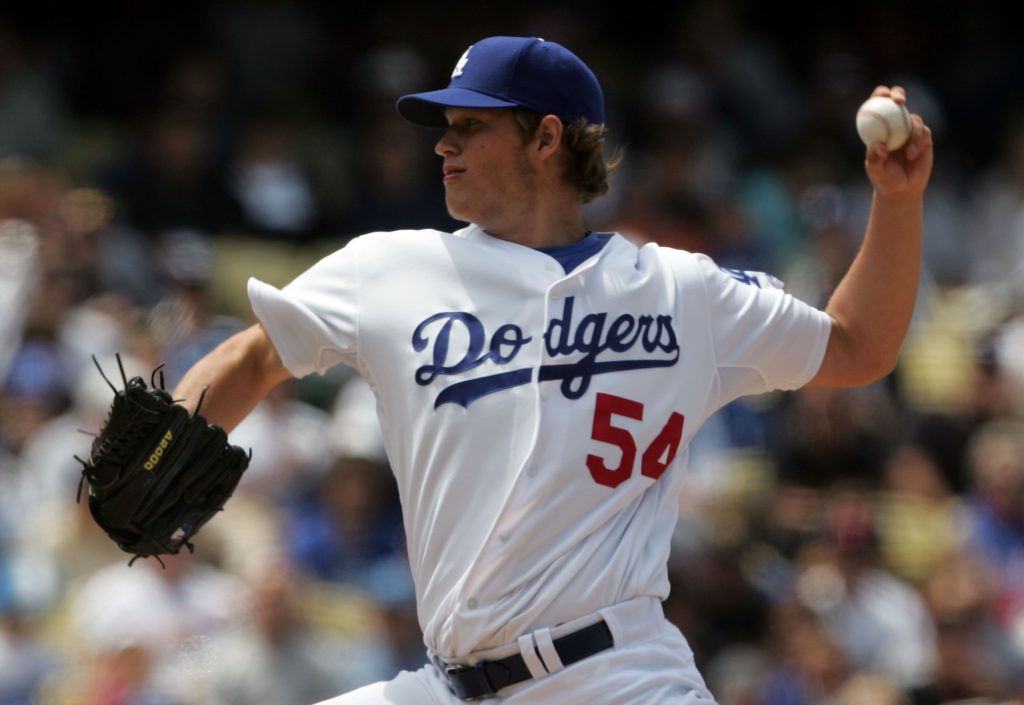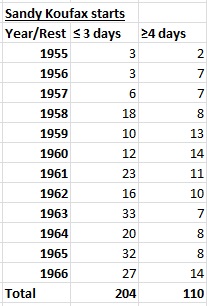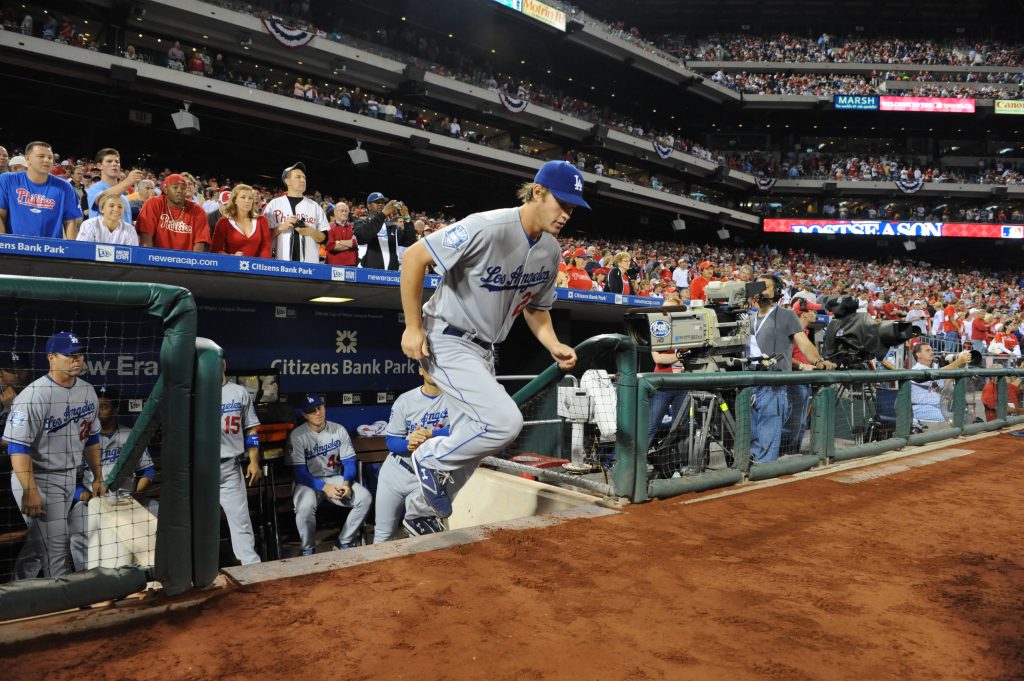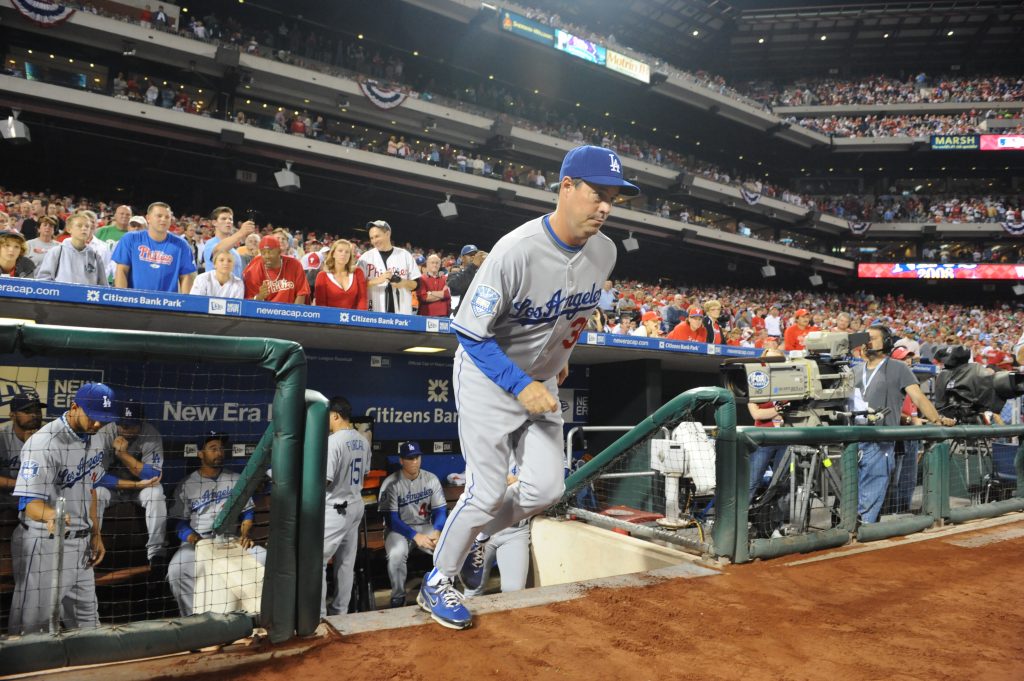
Clayton Kershaw, wearing No. 54, makes the first start of his big-league career on May 25, 2008. (Jeff Gross/Getty Images)
By Jon Weisman
Clayton Kershaw makes the 200th start of his Major League career tonight.
In Major League history, two pitchers have made 199 starts with an park/era-adjusted ERA (ERA+) of at least 150: Pedro Martinez and Kershaw.
Here are the top six pitchers in strikeouts per nine innings: Randy Johnson, Martinez, Nolan Ryan, Tim Lincecum, Kershaw, Sandy Koufax.
The top five in MLB history in Wins Above Average through age 26: Walter Johnson, Bert Blyleven, Christy Mathewson, Hal Newhouser, Kershaw.
* * *

The taboo against comparing Kershaw to Koufax has begun to fall away, as the full scope of Kershaw’s accomplishments resonates more and more among even the most diehard Koufax fans. At a minimum, fewer raise objections to mentioning them in the same sentence.
Whether Kershaw will end is career in the same stratosphere as Koufax is impossible to know. But speaking in the present, there’s no doubt that Kershaw has accomplished more by his age-26 season than Koufax has.
- Kershaw (2008-2014): 1,301 1/3 innings, 2.52 ERA, 2.77 FIP, 1.067 WHIP, 1,356 strikeouts, 150 ERA+
- Koufax (1955-1962): 1,131 2/3 innings, 3.71 ERA, 3.44 FIP, 1.314 WHIP, 1,168 strikeouts, 110 ERA+
Among the key distinctions made to elevate Koufax above Kershaw is the fact that Kershaw was part of a five-man rotation, while four-man rotations were common in the Koufax era. It’s a meaningful distinction, though perhaps overplayed in terms of how often Koufax started on three days’ rest:
 Especially at the outset of Koufax’s career, some of his starts that were technically on short rest came after brief appearances. For example, in his 1955 rookie season, Koufax is credited with a 14-strikeout August 27 shutout of the Reds on one day of rest, but in fact that was coming off an 11-pitch relief appearance on August 25 in the ninth inning with a five-run deficit, an outing that essentially was a glorified bullpen session.
Especially at the outset of Koufax’s career, some of his starts that were technically on short rest came after brief appearances. For example, in his 1955 rookie season, Koufax is credited with a 14-strikeout August 27 shutout of the Reds on one day of rest, but in fact that was coming off an 11-pitch relief appearance on August 25 in the ninth inning with a five-run deficit, an outing that essentially was a glorified bullpen session.
I’m absolutely not trying to minimize anything Koufax has accomplished here — Koufax threw 135 pitches in that 1955 shutout, at age 19, and you’ll be shocked to find that in his next appearance, he allowed four runs in an inning of relief. Live by the pitch-count freedom, die by the pitch-count freedom.
Koufax was not protected the way Kershaw was; he was used almost haphazardly. He was anything but sacred for the first several years of his career, and the fact that he became as incredible as he did speaks to his miraculous qualities.
But when people have said that you can’t compare Kershaw to Koufax, the Koufax they’re really speaking of didn’t even arrive until age 27, the year of his first Cy Young Award. Kershaw doesn’t turn 27 until next year.
Ultimately, comparing Kershaw to Koufax is apples to oranges (the very best apples and oranges you’ve ever tasted). Kershaw will never have the opportunity to prove that he could match or surpass Koufax on three days’ rest. Kershaw will never crack 300 innings in a season. And for that we can be grateful, because thanks to those restrictions, Kershaw has a much better chance to pitch past the age of 30, perhaps another decade beyond Koufax’s playing life.
So when people like myself do compare Kershaw to Koufax, we’re really just trying to look for ways to shorthand the greatness of Kershaw. And it’s no shot at Koufax that in some ways, he does fall short. It simply speaks to how mindblowingly unreal Kershaw has been.
But for our conclusion, we’ll leave Koufax out of the copy:
Clayton Kershaw is the best pitcher of his age in Dodger history and probably one of the five best in Major League history. And as impossible as it seems, it’s possible he hasn’t peaked.












